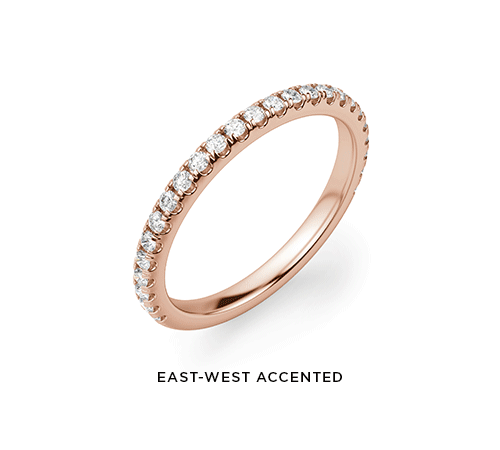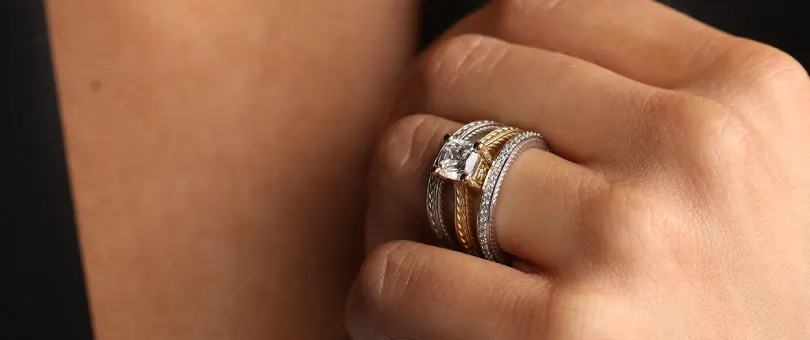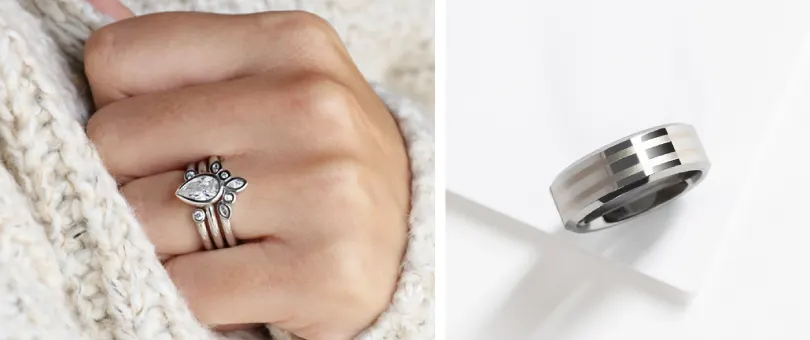How to Wear The Different Types of Wedding Rings and Bands
November 20th, 2023 / Alese Oldenburg
So much emphasis is placed on selecting the perfect engagement ring, it’s no wonder many of us forget about the actual wedding band. It seems as though there are thousands of resources available instructing men and women how to select the best-simulated diamond jewelry for the big proposal and although your beautiful engagement ring will probably always be the center of attention, understanding how to pick a band that will complement your ring is nearly as important. Just like engagement rings, your wedding band is a piece of high-quality jewelry that you will wear for the rest of your life. Plus, it actually can impact the appearance of your diamond, making it appear brighter or duller, bigger or smaller. How to wear your wedding rings is more important than you think.

Wedding Band Styles
Just as the engagement ring setting plays a pivotal role in showcasing the beauty of a stone, wedding bands also come in a variety of styles that contribute to the overall allure of the ring. Understanding these styles is essential for choosing the perfect band to complement your personal taste and engagement ring. Here’s a detailed exploration of some prominent wedding band styles:
Simple and timeless, a classic wedding band is an unembellished metal band. As plain as it may seem, however, there is a lot you can do to a classic band to make it the perfect fit for you, such as changing the metal, width, or profile of the band.

The term pavé refers to the way stones are set into the band. Stones- whether diamonds or diamond alternatives are delicately positioned close together and held in place by tiny beads of metal or prongs. The low profile design technique lays close to your finger and minimizes the appearance of metal, giving the ring a polished look. Pavé designs are most commonly seen with multiple rows of accents.

Most often used to hold larger stones in place, a shared prong basket band gives the visual appearance of a more structured design thanks to its thin prongs and metal bar. It is a versatile style, as the design can also be adjusted to accommodate smaller stones.

Explicitly designed to showcase the profile of the stones set into the band, a U-shaped style design holds the stones in place using only prongs. As a result, this type of wedding band is usually reserved for larger stones, although it can be adapted to a more delicate look as well.

Known for its sturdiness and polished appearance, a bezel band holds stones in place using a thin metal rim. Milgrain detailing is often used to add texture to the design, giving it a vintage feel.

A modern twist on the classic design, a channel band sets precious stones between the fixed walls of the band that hold them in place. Though the metal is much more prominent than other band styles, a channel design is a beautiful addition to nearly any engagement ring.

Also commonly referred to as Pinpoint, this sturdy setting features prong-set accents in a channel setting to keep them fastened in place. Along with it being safe for stones, the additional metal gives the design a little extra detail.

For a more eye-catching and polished look, a bar set wedding band holds stones in place using small walls of enclosed metal to add extra sparkle and shine to the ring’s appearance.

As you begin to narrow your design options, consider how your wedding band might complement or even enhance the appearance of your engagement ring. Though there is no right or wrong answer, there are some pairings that are known to make a perfect match. Here are some ideas to help you get started:
Nesting Band & Round Stone: A wedding band that has a notch that aligns with the shape of your stone, known as a nesting band, is an attractive option for a single round stone with a solitaire setting. The curvature of the wedding band will help frame the stone and may even make it appear larger by enhancing its sparkle and adding width. Plus, the small dip in the wedding band allows it to sit flush under the center stone of the engagement ring.
Chevron Band & Pear Stone: Fancy-shaped stones like marquise and pear are eye-catching all thanks to their unique cut. Adding a chevron, or V-shaped, wedding band mimics the style and emphasizes the shape. Depending on the orientation of the point of the chevron, you can use the band to add visual interest to your engagement ring.
Pavé Band & Halo Ring: A halo setting on an engagement ring is already a stunning statement piece, but if you want to add maximum sparkle, a pavé wedding band will help you achieve the look you want. The timelessness of a pavé band is an excellent choice for nearly any style of engagement ring, but when worn together, these two styles exceptionally highlight the beauty of one another.
Channel Band & Simple Stones: The channel wedding band style effortlessly creates the illusion of a matching set without being completely the same. The beauty of a channel band can easily add an air of sophistication and subtle enhancements to an engagement ring with a plain band or simple stone shape.
Eternity Band & Emerald Stone: For a more glamorous look, adding a band with stones continuously placed around the entire band – hence its name, the eternity band – adds a level of opulence that would not be achieved otherwise. Choosing a band that features the same cut of stone as your engagement ring such as emerald, princess or Asscher can create a beautiful set of rings.
Though these pairs can help inspire you, remember that whatever you choose is perfect as long as it looks beautiful to you. Putting together a set of rings offers you the opportunity to create something that reflects your unique style and will be enjoyable to see on your finger throughout your many years of marriage.
Stacking Engagement and Wedding Ring
The first step to selecting an appropriate wedding band is to know the setting and other specifications of your engagement ring. Classic engagement ring styles vs. unique styles will have different features. From the shape and size of the center stone to embellishments such as a halo, every design element of your engagement ring will affect the type of wedding band that will look best next to it. Some of the most popular shapes of engagement rings include round, cushion, princess, oval, emerald, pear, and marquise. Additionally, some of the most common engagement ring settings are the solitaire, cathedral, channel, bezel, and halo styles.
In addition to contemplating style overall, you’ll also need to consider how you want the wedding band to interact with your engagement ring. Would you prefer a band that is flush to the engagement ring with no gap, or would you find it suitable for there to be some space between the two bands? Having a preference for this, along with knowing the design details of your engagement ring, will help you pick the best style of wedding band. For example, engagement rings with high-profile settings such as a cathedral setting will most likely have enough space under the diamond for the wedding band to slide below, thereby becoming flush with the engagement band. Different styles will present various options to consider in terms of the look and feel of the two rings together.

Additionally, it’s essential to consider the metal used for your engagement ring when selecting your wedding band. Conventionally, a wedding band will be made using the same type of metal as the engagement ring to create a cohesive look. However, combining yellow gold with white gold or platinum can create a contrasting look that is appealing to some. As a result, selecting two types of metals is an option that can create a more individualized look unique to your style.
Purchasing Tips
Beyond the style and cohesiveness of your two rings, several logistical tips can help ensure you find the perfect wedding band for you.
Know Your Budget: When you start shopping for the perfect wedding ring, it’s hard not to be distracted by all the beauty and splendor in front of you and then end up paying much more than you had intended. Setting a budget before you start shopping will help you keep pricing front of mind. You can even ask the jeweler to show you items that are in your price range. A good rule of thumb is to remember that the more carat weight a ring contains, the higher the price will be. However, be sure to consider other options like lab-created diamond simulants as well, which are stunning diamond alternative options that also present much more affordable price points.
Buy Together: Some jewelers or stores design matching bridal sets that come at a discounted price and take some of the guesswork out of creating a beautiful pair. This makes choosing a wedding band easy but doesn’t offer as much customization depending on who you’re working with.
Don’t Forget Your Partner: Traditionally, couples have selected matching metal bands to symbolize their unification as one and exemplify that they belong together. This comes down to personal preference, but if it’s a sentiment you identify with, consider how your bride or groom’s ring will accompany your ring set.

Consider Your Lifestyle: If you tend to gesture while speaking or use your hands a lot throughout the day, a multi-diamond band may not be the most suitable choice for you. The chances of you hitting the ring against something or getting it dirty are higher, meaning that the ring could become damaged or dull quickly. While there are many beautiful and extravagant rings and bands available, remember that not all may be the best fit for the way you choose to live your life.
Try it On: Actually seeing a ring and its style on your hand may influence what you want to purchase. If you can, try the ring on. You may find that what you had in mind is the perfect match, or that you like a particular wedding band style or combination of metals that you never thought you would!
Maintenance Matters: Regular maintenance is an important part of jewelry upkeep – wedding and engagement ring care should definitely be considered when you’re making a purchase. For example, some issues include prongs becoming loose or bent, diamonds falling out, or the band becoming scratched through wear and tear. Visiting your jeweler a few times each year for an inspection will help prevent some of these scenarios, but larger stones with more elaborate designs may require more frequent visits and cleanings to keep them in their best condition.
Timing is Everything: Figuring out where to wear the engagement ring and wedding band together may take longer than you think. The last thing you want is to be scrambling before your wedding to find a band that you like. Start your search at least two to three months before the big day so you have plenty of time to experiment and browse to find your ideal bridal set. Allowing yourself more time also gives you the option to have the ring engraved or incorporate other customizations.
When it comes to how to wear wedding bands and engagement rings together, there is really no wrong answer. Understanding your unique style and the basics of rings will allow you to create a bridal set that you’ll love to see on your hands. Use the pairings above to help inspire your design, but most importantly, make sure that whatever you choose is beautiful to you!
*Here at Diamond Nexus, we strive to provide valuable information while being clear and honest about our products. The Nexus Diamond™ alternative is a patented lab-created diamond simulation that, among all simulants, most closely imitates the look, weight, and wear of a diamond, with two exceptions – it is absolutely perfect in every way, and it costs significantly less. Price points and environmental facts expressed in this blog were taken from popular online retailers and may vary. Learn more about the environmental impact of mining by visiting our blog: blog.

